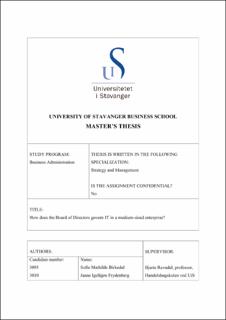| dc.contributor.advisor | Ravndal, Bjarte | |
| dc.contributor.author | Frydenberg, Janne | |
| dc.contributor.author | Birkedal, Sofie | |
| dc.date.accessioned | 2020-09-21T14:04:52Z | |
| dc.date.available | 2020-09-21T14:04:52Z | |
| dc.date.issued | 2020-06 | |
| dc.identifier.uri | https://hdl.handle.net/11250/2678875 | |
| dc.description | Master's thesis in Strategy and Management | en_US |
| dc.description.abstract | The purpose of this case study research has been to identify and provide more descriptive research on how the board of directors governs IT. Research on IT governance has confirmed that the involvement of board of directors in IT decisions increases organizational performance, regardless of IT needs in the enterprise. The board of directors is ultimately responsible for the performance of the enterprise. This means that they have to ensure the right governance model for the enterprise, which should include IT governance.
In this descriptive case study research, we have used a triangulation of data collection. Conducting semi-structured interviews with the Chair of the Board, the CEO, and the Strategy and Development Manager in the enterprise, analyzing their board protocols for the last five years, observation of two board meetings, and lastly, conducted an unstructured interview with expert informants at a consultancy company. The data collection has given us the fundament to describe how IT is governed concerning structures, processes, and relational mechanisms at the board-level.
This study reveals that the chosen enterprise has developed into a strategic mode. They score high in the need for reliable technology as well as the need for new information technology. Where the latter has become more important in the last years due to the demand and expectations from their customers. The enterprise has several market-leading projects where information technology plays a crucial role. They are perceived as successful in technological development from the service and products they supply. However, we raise some uncertainty whether the Board has fully adapted to the strategic mode.
To further adopt IT governance at the board level, the Board is recommended to evaluate an IT oversight or similar committee, which also will strengthen its strategic mode. We further argue that the Board should have a structured approach when elaborating on IT-related matters, and lastly, effective communication to and from the Board by having the S&D Manager attend the board meetings more often. Together these recommendations will contribute to better alignment of business and IT, which will further enable increased business value. | en_US |
| dc.language.iso | eng | en_US |
| dc.publisher | University of Stavanger, Norway | en_US |
| dc.relation.ispartofseries | Masteroppgave/UIS-HH/2020; | |
| dc.rights | Navngivelse 4.0 Internasjonal | * |
| dc.rights.uri | http://creativecommons.org/licenses/by/4.0/deed.no | * |
| dc.subject | økonomi | en_US |
| dc.subject | administrasjon | en_US |
| dc.subject | strategi og ledelse | en_US |
| dc.subject | board of directors | en_US |
| dc.subject | governance of IT | en_US |
| dc.title | "How does the Board of Directors govern IT in a medium-sized enterprise?" | en_US |
| dc.type | Master thesis | en_US |
| dc.subject.nsi | VDP::Social science: 200::Economics: 210::Business: 213 | en_US |

